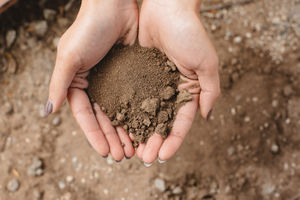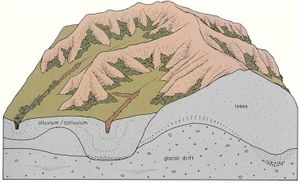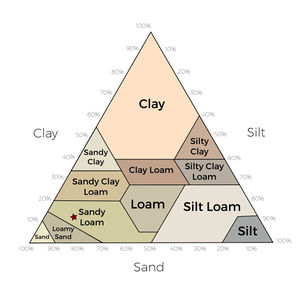Silt: Difference between revisions
m The LinkTitles extension automatically added links to existing pages (<a rel="nofollow" class="external free" href="https://github.com/bovender/LinkTitles">https://github.com/bovender/LinkTitles</a>). |
|||
| (13 intermediate revisions by 2 users not shown) | |||
| Line 1: | Line 1: | ||
[[File:Silty.jpg|thumb|right|Silt [6]]] | |||
==Definition== | ==Definition== | ||
Silt is a granular sediment that can be transported and deposited by water, ice, and wind. Silt particles are larger than clay, but smaller than [[sand]]. To be classified as silt, a particle must be between .002 to .05 mm [1]. Similarly to [[clay]], [[sand]], and [[gravel]], silt is found in [[soil]]. Silt can also occur as sediment mixed in suspension with water. Because of silt’s spherical shape, it retains a large amount of water. Silty soil is known to be more fertile than other soils, and many species of [[organisms]] thrive in it. | |||
Silt is a granular sediment that can be transported and deposited by water, ice, and wind. Silt particles are larger than clay, but smaller than sand. To be classified as silt, a particle must be between .002 to .05 mm [1]. Similarly to [[clay]], sand, and gravel, silt is found in [[soil]]. Silt can also occur as sediment mixed in suspension with water. Because of silt’s spherical shape, it retains a large amount of water. Silty soil is known to be more fertile than other soils, and many species of [[organisms]] thrive in it. | |||
[[File:loess.jpg|thumb|left|Loess [7]]] | |||
==Formation== | ==Formation== | ||
Silt-producing mechanisms include frost shattering (Freeze-Thaw Weathering), comminution during transport, eolian abrasion, salt weathering, and glacial grinding. Windblown silt blankets the land in many parts of the world [2]. Large deposits of silt, such as this, are known as loess. Loess landscapes are usually a sign of past glacial activity, including areas such as the Great Plains. Silt can accumulate quickly in areas that lack vegetation, which can disrupt ecosystems. Silt also settles in still water, resulting in build ups like deltas. The main mineral origin of silt is quartz and feldspar [3]. | Silt-producing mechanisms include frost shattering (Freeze-Thaw Weathering), comminution during transport, eolian abrasion, salt weathering, and glacial grinding. Windblown silt blankets the land in many parts of the world [2]. Large deposits of silt, such as this, are known as loess. Loess landscapes are usually a sign of past glacial activity, including areas such as the Great Plains. Silt can accumulate quickly in areas that lack vegetation, which can disrupt ecosystems. Silt also settles in still water, resulting in build ups like deltas. The main mineral origin of silt is quartz and feldspar [3]. The formation and movement of silt are constantly altering ecosystems. | ||
==Identification== | ==Identification== | ||
Silt soil is fine and feels like flour when dry. When silt is wet it becomes a smooth mud that can be easily molded into shapes. When silt soil is very wet, it blends seamlessly with water, and forms puddles of mud [4]. Silt particles are very small, so they have a very smooth texture. Silty soil drains well, but not as quickly as sand. Silts sparkly appearance can be observed using a hand lens. Pure silts are identified by their lack of cohesion. Silts and clays are distinguished by their plasticity [5]. | Silt soil is fine and feels like flour when dry. When silt is wet it becomes a smooth mud that can be easily molded into shapes. When silt soil is very wet, it blends seamlessly with water, and forms puddles of mud [4]. Silt particles are very small, so they have a very smooth [[soil texture]]. Silty soil drains well, but not as quickly as [[sand]]. Silts sparkly appearance can be observed using a hand lens. Pure silts are identified by their lack of cohesion. Silts and clays are distinguished by their plasticity [5]. | ||
==Field Identification== | |||
*Dry Strength Test | |||
Mold a small briquette of the soil and allow to dry in the air. Break a small fragment about 1.0 cm in size and press between thumb and forefinger. The effort required to break the fragment provides a basis for describing the strength as ver low, low, medium, high or very high. A silt fragment crushes easily. | |||
*Dilatancy or Shaking Test | |||
Silts are considerably more permeable than clays. A small amount of soil is mixed with water to a very soft consistency in the palm of the hand. The back of the hand is then lightly tapped. If the soil is silty, water rises quickly to its surface and gives it a shiny or glistening appearance. Then if the soil pat is deformed, in some instances by squeezing and in others by stretching, the water flows back into it and leaves the surface with a dull appearance. The reaction is described as rapid, slow or none. | |||
*Roughness/Plasticity Test | |||
Silt can seldom be rolled into a thread with a diameter as small as 3mm without severe cracking, and lacks tensile strength. A simple plasticity test should indicate whether a plastic thread can be formed, and also the toughness of the thread as it nears the crumbling stage. This condition is described as weak and friable, medium, or tough. | |||
*Dispersion Test | |||
A small quantity of the soil is put in water in a glass cylinder or test tube and then allowed to settle. The coarser particles fall out first and the finest particles remain in suspension the longest. Materials of silt size settles in 15 to 60 min. [7] | |||
[[File:soilmodel.jpg|thumb|right|[8]]] | |||
==See also== | ==See also== | ||
| Line 41: | Line 62: | ||
[5] | [5] | ||
NRCS, USDA. "National soil survey handbook, title 430-VI." (2007). | |||
[6] | [6] | ||
“Silt: Environmental Impact.” Rashid's Blog: An Educational Portal, 8 May 2016, rashidfaridi.com/2016/03/04/silt-environmental-impact/. | “Silt: Environmental Impact.” Rashid's Blog: An Educational Portal, 8 May 2016, rashidfaridi.com/2016/03/04/silt-environmental-impact/. | ||
[7] | |||
“Loess Hills.” Iowa Geological Survey, 11 July 2017, www.iihr.uiowa.edu/igs/loess-hills/?doing_wp_cron=1525843720.4534800052642822265625. | |||
[8] | |||
“Choosing a Topsoil Mix for Your Yard or Garden.” Washington Rock Quarries, 23 Mar. 2017, www.wa-rock.com/choosing-topsoil-mix-yard-garden/. | |||
Latest revision as of 13:30, 31 March 2023

Definition
Silt is a granular sediment that can be transported and deposited by water, ice, and wind. Silt particles are larger than clay, but smaller than sand. To be classified as silt, a particle must be between .002 to .05 mm [1]. Similarly to clay, sand, and gravel, silt is found in soil. Silt can also occur as sediment mixed in suspension with water. Because of silt’s spherical shape, it retains a large amount of water. Silty soil is known to be more fertile than other soils, and many species of organisms thrive in it.

Formation
Silt-producing mechanisms include frost shattering (Freeze-Thaw Weathering), comminution during transport, eolian abrasion, salt weathering, and glacial grinding. Windblown silt blankets the land in many parts of the world [2]. Large deposits of silt, such as this, are known as loess. Loess landscapes are usually a sign of past glacial activity, including areas such as the Great Plains. Silt can accumulate quickly in areas that lack vegetation, which can disrupt ecosystems. Silt also settles in still water, resulting in build ups like deltas. The main mineral origin of silt is quartz and feldspar [3]. The formation and movement of silt are constantly altering ecosystems.
Identification
Silt soil is fine and feels like flour when dry. When silt is wet it becomes a smooth mud that can be easily molded into shapes. When silt soil is very wet, it blends seamlessly with water, and forms puddles of mud [4]. Silt particles are very small, so they have a very smooth soil texture. Silty soil drains well, but not as quickly as sand. Silts sparkly appearance can be observed using a hand lens. Pure silts are identified by their lack of cohesion. Silts and clays are distinguished by their plasticity [5].
Field Identification
- Dry Strength Test
Mold a small briquette of the soil and allow to dry in the air. Break a small fragment about 1.0 cm in size and press between thumb and forefinger. The effort required to break the fragment provides a basis for describing the strength as ver low, low, medium, high or very high. A silt fragment crushes easily.
- Dilatancy or Shaking Test
Silts are considerably more permeable than clays. A small amount of soil is mixed with water to a very soft consistency in the palm of the hand. The back of the hand is then lightly tapped. If the soil is silty, water rises quickly to its surface and gives it a shiny or glistening appearance. Then if the soil pat is deformed, in some instances by squeezing and in others by stretching, the water flows back into it and leaves the surface with a dull appearance. The reaction is described as rapid, slow or none.
- Roughness/Plasticity Test
Silt can seldom be rolled into a thread with a diameter as small as 3mm without severe cracking, and lacks tensile strength. A simple plasticity test should indicate whether a plastic thread can be formed, and also the toughness of the thread as it nears the crumbling stage. This condition is described as weak and friable, medium, or tough.
- Dispersion Test
A small quantity of the soil is put in water in a glass cylinder or test tube and then allowed to settle. The coarser particles fall out first and the finest particles remain in suspension the longest. Materials of silt size settles in 15 to 60 min. [7]

See also
- Clay
- Loam
- Founders of Soil Concepts
- Humus
- Microorganisms
- Pedogenesis
- Soil
- Soil Textures
- Soil Properties
- Jenny Equation
References
[1] National Geographic Society. “Silt.” National Geographic Society, 9 Oct. 2012, www.nationalgeographic.org/encyclopedia/silt/.
[2] Wright, Janet S. "“Desert” loess versus “glacial” loess: quartz silt formation, source areas and sediment pathways in the formation of loess deposits." Geomorphology 36.3-4 (2001): 231-256.
[3] Wright, J. S., Smith, B. J. & Whalley, W. B. Mechanisms of loess-sized quartz silt production and their relative effectiveness: Laboratory simulations. Geomorphology 23, 15-34 (1998).
[4] Wentworth, Chester K. "A scale of grade and class terms for clastic sediments." The journal of geology 30.5 (1922): 377-392.
[5] NRCS, USDA. "National soil survey handbook, title 430-VI." (2007).
[6] “Silt: Environmental Impact.” Rashid's Blog: An Educational Portal, 8 May 2016, rashidfaridi.com/2016/03/04/silt-environmental-impact/.
[7] “Loess Hills.” Iowa Geological Survey, 11 July 2017, www.iihr.uiowa.edu/igs/loess-hills/?doing_wp_cron=1525843720.4534800052642822265625.
[8] “Choosing a Topsoil Mix for Your Yard or Garden.” Washington Rock Quarries, 23 Mar. 2017, www.wa-rock.com/choosing-topsoil-mix-yard-garden/.